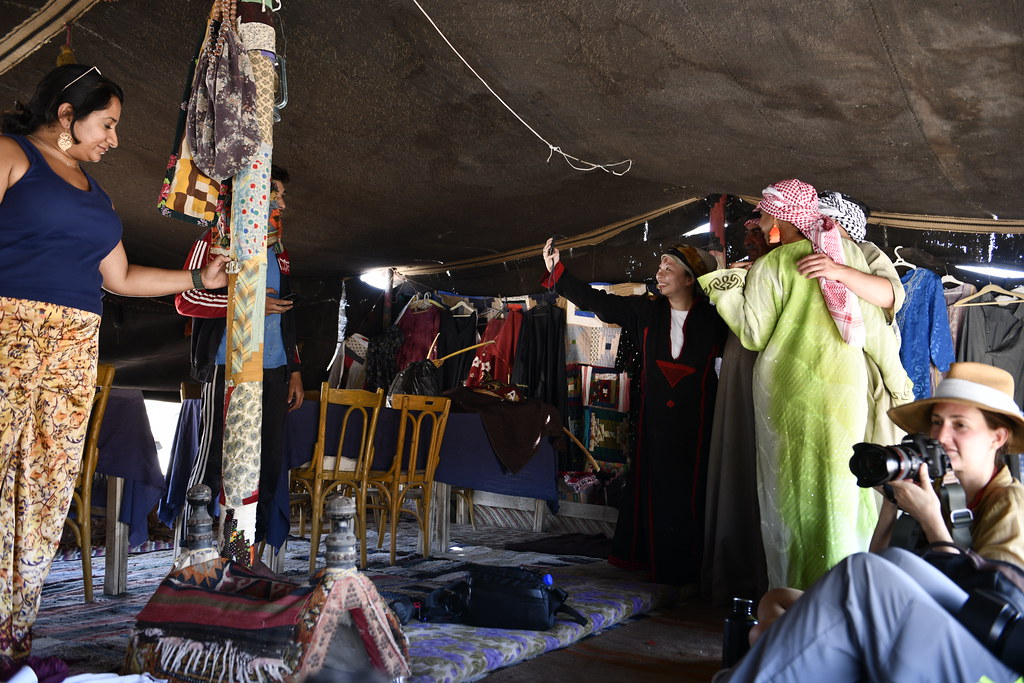Today is the day most of us have been waiting for: We drive to Palmyra, the crown jewel of archaeological sites in Syria.

Right by the sign that leads to Palmyra, we’d warn you not to pick up any stray hitchhikers along the way.
From Mishtaya we drove 3 hours first into the town of Palmyra where we stopped for quick falafel sandwiches to hold us over while the rest of us salivated over their shawarma in the making.


The ruins of Palmyra’s ancient city is right by the inhabited town, which remnants date back to the Neolithic period and has changed hands among various empires before it became a subject of the Roman Empire.
A word of warning for those with limited space on their cameras or phones: this place is as photogenic in photos as it is in real life.
After the Roman Empire fell, Palmyra became a minor center under the Byzantines and future empires. Over its storied history Palmyra has been destroyed and rebuilt on numerous occasions before it finally became a time capsule and excavation site.
We first stopped and walked down underground into an ancient burial site and tomb for wealthy families from Palmyra. Don’t forget your headlamp.
While underground, turn left to find a narrow passageway and climb in see an excavation still in progress. It can get a little claustrophobic here.
After getting back above ground, we visited a nearby spring that demonstrated Palmyra to be the desert oasis that allowed civilizations to thrive here and even once challenge Rome for influence within its empire.

Although Daesh destroyed large parts of Palmyra 7 years ago, it was recaptured by the Syrian Army on March 2nd 2017. And to their surprise when they liberated Palmyra, much of the old city remained intact. Therefore there’s still a lot to see here.

Palmyra’s wealth as traders along the Silk Road had enabled the construction of monumental projects for a city at the time, such as the the agora:


If you look for it by the entryway, there is an ancient inscription that acts like a Rosetta Stone for 3 different languages on how to conduct yourself in the agora and markets that had once stood here.
We then walked down the Great Colonnade:


…and reached the theater, which acoustics still remarkably work.
More sobering, however. this was also where Daesh conducted public executions when they had occupied Palmyra 7 years ago.
Next we moved on from the theater to take a group photo under the monumental arch:
…before relaxing our legs under the shade for an hour at the local bedouin camp nearby. There they served us tea, shisha, and even let us try on bedouin wear for an impromptu fashion show.
This was also where Chris subtly expressed his love for his Syrian adobo, our assigned security officer at Palmyra, who then later admitted he had known all along before he bid us farewell.
Before leaving Palmyra, we made one final stop at the Temple of Bel. Here Sampson helpfully whipped out a 3-D printed replica of what the Temple of Bel had looked like before its destruction at the hands of Daesh:
After about 2 hours in Palmyra, we headed back west to the city of Homs for dinner.

Show off your favorite snack:
Once arriving in Homs, we were met by the family of Ophelia’s boss Fadi, who had prepared us an indelible home cooked feast.
They even unveiled a surprise birthday cake for Sampson, who almost got away with not letting us know!

We proceeded to then let them teach us a Syrian type of celebratory dance while we in return showed them the Electric Slide, Jerusalema, and Soulja Boy.
As the sun began to set we thanked the family and headed out from Homs.
Because there currently exists no infrastructure to accommodate tourists in Homs, we drove about an hour’s north to Hama to turn in at Nora Hotel.

After half an hour to freshen up at the hotel, we went back downstairs for booza and other desserts next door.
![]()
- At time of posting in Palmyra, it was 32 °C - Humidity: 17% | Wind Speed: 6km/hr | Cloud Cover: feels like the Greek heat wave again

























